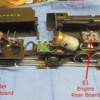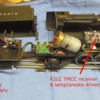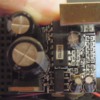I can't find a condensed troubleshooting guide for TMCC/Railsounds on the web or in the forum or a parts breakdown for my engine and tender. Is there one somewhere?
I have lost all sound on my steam Pennsy K4 #3678 bought new circa 2004 IIRC. I started having problems three weeks ago after a minor derailment with track short that popped the quick acting breaker I have on the track. It began as stuttering chuffs that over the course of a week dropped out to no chuffing, just random trackside sounds while it was running. The whistle and bell, and other sounds still worked. I tried a factory reset - no effect. I tried reseating the card inside the engine and that seemed to bring the chuffing back for awhile, but the problem quickly returned. Over time I also lost the squeal from the brakes. The other day I finally looked in the tender and discovered two boards there. I removed and reseated both, since both seemed to be riding a little high on their pins. I seated both fully down. After powering up the track lights were dim and I smelled smoke coming from the forward board in the tender. I quickly shut off the power, but now I have no sound at all. The large capacitor on the right side of the tender and the shielded coil on the same side toward the front of the board felt warm. I could not see any bulging of the capacitor - the usual sign that it's blown and I couldn't spot any burned areas on the board itself. I removed and reseated both boards a little higher and retried, but no sound at all now. Running it with the naked ZW without the radio control also has no sound. This engine has been jinxed since purchase. It stopped smoking after a similar minor derailment / track short shortly after purchase and that was repaired under warranty. (Are these electronics that fragile that a simple short kills them?) What do I do next? I have no spare boards to substitute.










